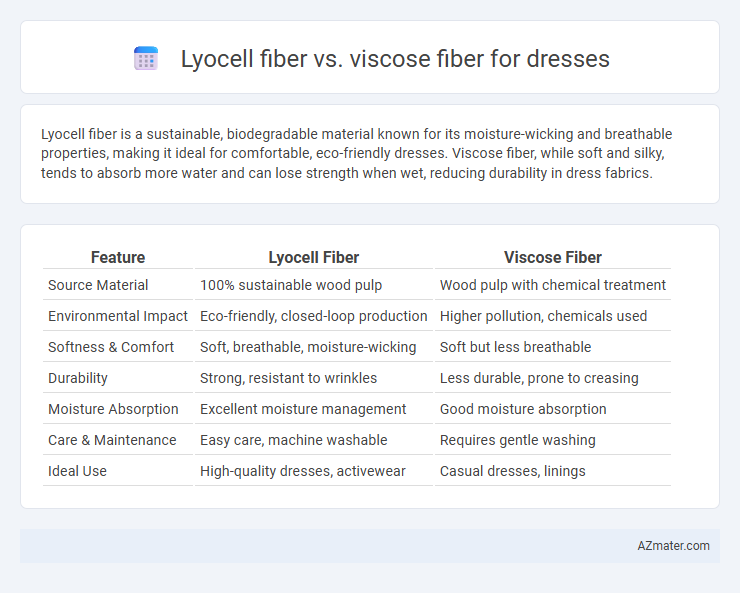Lyocell fiber is a sustainable, biodegradable material known for its moisture-wicking and breathable properties, making it ideal for comfortable, eco-friendly dresses. Viscose fiber, while soft and silky, tends to absorb more water and can lose strength when wet, reducing durability in dress fabrics.
Table of Comparison
| Feature | Lyocell Fiber | Viscose Fiber |
|---|---|---|
| Source Material | 100% sustainable wood pulp | Wood pulp with chemical treatment |
| Environmental Impact | Eco-friendly, closed-loop production | Higher pollution, chemicals used |
| Softness & Comfort | Soft, breathable, moisture-wicking | Soft but less breathable |
| Durability | Strong, resistant to wrinkles | Less durable, prone to creasing |
| Moisture Absorption | Excellent moisture management | Good moisture absorption |
| Care & Maintenance | Easy care, machine washable | Requires gentle washing |
| Ideal Use | High-quality dresses, activewear | Casual dresses, linings |
Introduction to Lyocell and Viscose Fibers
Lyocell fiber is a sustainable cellulose fiber made from wood pulp, known for its eco-friendly closed-loop production process that minimizes environmental impact. Viscose fiber, also derived from cellulose, undergoes a chemical-intensive manufacturing method that releases harmful byproducts, making it less environmentally beneficial. Both fibers offer softness and breathability ideal for dresses, but Lyocell provides superior moisture-wicking and durability properties compared to viscose.
Fiber Production Process: Lyocell vs Viscose
Lyocell fiber production uses a closed-loop process where wood pulp is dissolved in non-toxic N-Methylmorpholine N-oxide solvent, allowing for more environmentally friendly and sustainable manufacturing with minimal chemical waste. In contrast, viscose fiber production involves chemical-intensive steps using sodium hydroxide and carbon disulfide, generating toxic by-products and requiring extensive water and energy consumption. The closed-loop system in lyocell results in higher purity fibers and less environmental impact compared to the open and chemically harsh viscose process, making lyocell a preferred choice for eco-conscious dress fabrics.
Sustainability and Environmental Impact
Lyocell fiber, derived from sustainably sourced wood pulp through a closed-loop process, significantly reduces water and chemical consumption compared to viscose fiber production, which relies on toxic chemicals and generates hazardous waste. Lyocell's biodegradability and minimal environmental footprint make it a superior choice for eco-friendly dress manufacturing, whereas viscose often contributes to deforestation and pollution due to unsustainable forestry practices and chemical-intensive processing. Choosing lyocell promotes sustainability by supporting renewable materials and reducing harmful emissions associated with traditional viscose fiber production.
Comfort and Wearability for Dresses
Lyocell fiber offers superior breathability and moisture-wicking properties compared to viscose, making dresses more comfortable in warm weather. Lyocell's smooth, soft texture reduces skin irritation, enhancing wearability for sensitive skin, while viscose tends to be less durable and more prone to wrinkles. Dresses made from Lyocell maintain their shape and softness after multiple washes, providing long-lasting comfort and ease of care.
Durability and Longevity in Apparel
Lyocell fiber offers superior durability and longevity in apparel compared to viscose due to its stronger cellulose structure and resistance to abrasion and pilling. Dresses made from lyocell maintain shape and color retention over multiple washes, while viscose fibers tend to weaken and lose vibrancy more quickly. The eco-friendly production process of lyocell also enhances its sustainability, making it a preferred choice for long-lasting and durable dresses.
Moisture Absorption and Breathability
Lyocell fiber exhibits superior moisture absorption by efficiently wicking sweat away from the skin, making it ideal for breathable, comfortable dresses in warm climates. Viscose fiber also offers good moisture retention but tends to dry slower, which can reduce overall breathability and comfort during extended wear. The eco-friendly production process of Lyocell further enhances its appeal for sustainable fashion focused on performance and softness.
Dyeing, Color Retention, and Aesthetics
Lyocell fiber exhibits superior dye absorption and color retention compared to viscose, resulting in more vibrant, long-lasting hues ideal for dresses. Its smooth, lustrous surface enhances fabric aesthetics with a soft hand feel and elegant drape, surpassing the often duller appearance of viscose. Lyocell's eco-friendly production and resilience to fading make it a preferred choice for high-quality, visually appealing garments.
Care, Maintenance, and Washability
Lyocell fiber offers superior care and maintenance compared to viscose, as it is more resistant to wrinkles and shrinkage, making it easier to wash and maintain. Lyocell garments can be machine washed on a gentle cycle with cold water, while viscose often requires hand washing or dry cleaning to prevent damage. The moisture-wicking properties of lyocell also contribute to faster drying times and less fading, enhancing the longevity of dress fabrics.
Cost Comparison: Lyocell vs Viscose Dresses
Lyocell dresses typically have a higher upfront cost compared to viscose dresses due to more sustainable production methods and superior durability. Viscose dresses are generally cheaper to produce and purchase, making them a budget-friendly option but often at the expense of environmental impact and fabric longevity. The cost difference reflects Lyocell's eco-friendly manufacturing process and enhanced moisture-wicking properties, which justify the premium price for quality-conscious consumers.
Choosing the Right Fiber for Your Dress
Lyocell fiber offers superior breathability, moisture-wicking properties, and eco-friendly production compared to viscose fiber, making it an excellent choice for comfortable and sustainable dresses. Viscose is softer and more affordable but tends to wrinkle easily and may lose strength when wet. Opting for lyocell ensures durability, a silky texture, and reduced environmental impact, ideal for high-quality dress materials.

Infographic: Lyocell fiber vs Viscose fiber for Dress
 azmater.com
azmater.com